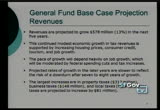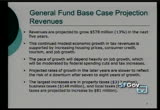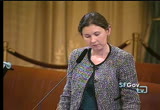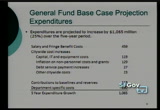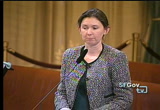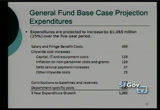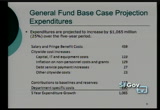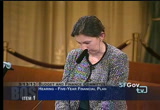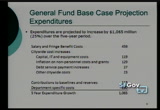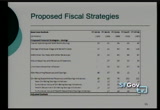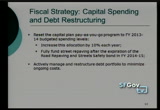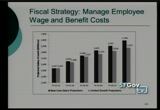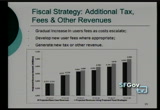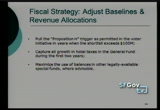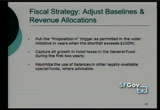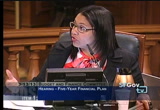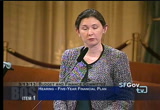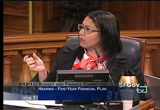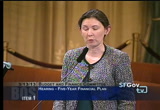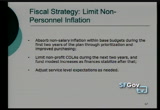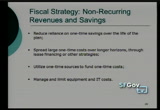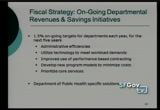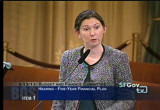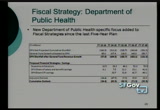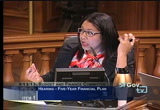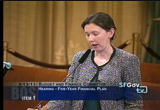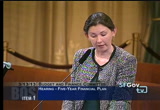tv [untitled] March 17, 2013 6:30pm-7:00pm PDT
6:30 pm
what we -- than we're factoring in at the moment, those projections could change. overall, the plan assumes more conservative growth rates on revenue in the third, fourth and fifth years of the plan. one to have reasons for that is that we are now going into a pretty -- into a sustained period of economic recovery and over the last number of years, we know that we haven't been able to -- we've seen booms and busts in our economy so we need to be i think responsible in our revenue projections in those third, fourth and fifth years. there's still growth rates assumed but just at a lower level. >> ms. howard, quick question for you, and i appreciate that comment, i think as you look at economic cycles and so forth, you can make an argument that we're going into a shorter
6:31 pm
economic swing, have you guys done any look at all about a down side scenario if you will? >> the plan doesn't project a down-side scenario, what we did do though and i didn't put it in the presentation but if you look in the plan itself, if each year we had 1% less revenue growth than we project in the plan, that would be about 134 million dollars loss, so to the degree that revenues come in lower than expected, the deficit would be larger, so there is some sensitivity here. >> and that's 134 million over five years? >> over five years, that's right. >> got it, thanks. >> so, going back to just in term of what compromises that 578 million dollars of revenue growth, the largest portion of that being our property tax
6:32 pm
which is our largest overall local revenue source, though business taxes and our hotel and sales taxes are as growing over that time period. this slide highlights for you wla the projected growth rates are in the plan, so you can see, you know, stronger growth rates in the early first two years and more moderate projections in the subsequent years. on the expenditure side, our -- the city's expenditures are projected to increase by 1.1 billion dollars over the five year period, that's about 25% growth, and the largest share of that is our salary and fringe benefit costs which are growing we're projecting 460 million dollars, there are a number of citywide cost increase that is are assumed in this plan, things like fully funding our capital plan, our
6:33 pm
it plan and equipment costs, the plan also assumes that we fully fund inflation on grants as well as other non-personnel services, so that's all the contracts, grants, and other types of expenditures that are not staff costs. >> supervisor breed? >> yes, can you please explain what you mean by fully fund capital plan? >> happy to answer that question, supervisor, so the capital plan which will be before you in two weeks i think recommends a certain level of expenditure on the city's capital assets, it includes things like streets, facilities, maintenance, that sort of thing. the plan recommends a certain level of general fund support. this year, i believe it's approximately 80 million
6:34 pm
dollars, and that number grows over the life of the plan. one of the recommendations that the capital plan makes is that the city should fund the level that it's funding today and then grow that amount by 10% every year, and the reason for that is that the city has a significant backlog in term of maintaining our facilities, maintaining the facilities that we own. >> so, and fully funding it, it would include long-term maintenance rather than deferred because it would help address those deferred maintenance issues? >> that's right, and the director of the capital planning program will be eager to talk to you about this, the capital plan that's before you this year, it will be the first plan that during the ten year planning window, we begin to make progress on that backlog which would be real progress if we were able to do that.
6:35 pm
now, i would point out to you and i think many of you know this, the city has not been able to fully fund the capital plan ever, and so, you know, i think there's one of the things that this five-year financial plan recommends is taking a look at what we can really afford and what are realistic expectations given that the city hasn't been able to make those commitment ins the past. >> thank you. >> other highlights that i would note for you here, the contributions that the city will be required to make to our baselines and reserves grows over the five-year period, so that's our general reserve as well as transfers to the new housing trust fund to the children's fund, and other baselines, mta as well.
6:36 pm
the last line here, department specific costs is related to all other costs that are really connected specifically to a department, so that could be things like the cost of elections, it could be the cost of our human services aid budge and how that changes over time, the largest component though of this is our cost related to the health department, so you'll see in the plan and as we talk about this that there's some hard work that the city needs to do with the health department about what can we afford and how do we structure our system of care so that we maintain a safety net that's really viable. >> just so you know, we're having a separate hearing on the health department and the issues ms. howard just
6:37 pm
identified, quick question for you, within the salary and fringe benefit cost, obviously the largest increase over the next five years, in terms of percentages, what is that salary versus fringe benefit cost and then within fringe off the top of your head, and if i'm calling you out inappropriately, you can call me out to task in that. >> you're not calling me out inappropriately. let's see here. so, the -- i'm looking at page 17 of the overall plan which is table 4, and so what you'll see is a sub table there that describes salaries and benefits and you can see that in the early years, our closed labor costs and the annual are about
6:38 pm
60 million dollars and when we start to apply inflation into those open labor contracts and that's just a projection, we'll negotiate with our employees, that's about 180 million there, so of that total, 460 million dollars in wages and benefits, it's approximately 200 million, 220 million or so in salaries and the remainder in benefits. >> thank you. >> one thing to note here is that over the next two years, so we'll see about 50 million dollars in continued increased cost in the city guide for our pension benefits and the next year, another 50 million, so in the next two years, 100 million dollars in pension contributions, prop c has made a difference but we're still feeling the effects of the recession and the smoothing
6:42 pm
dpsh the numbers and the plan are based on assuming that we reset our capital spending to the level that's included in the budget that you all adopted last year, so that 40 million dollar level and that we then grow from there. so, that would be a significant reduction to our capital spending, but i think it's certainly something we need to think about. one caveat to that is you all will remember that the voters passed the road repaving and streets bond several years ago and it will expire in fiscal 14-15, so this plan does assume that the full cost of maintaining our streets is funded. and then secondly, we've i think the controller's office has done a very good job over the years at actively managing our debt portfolio so we are able to generate savings to the general fund and to the city as
6:43 pm
we're able to do that, and so that is another strategy that i think we should continue to pursue. on the wage and benefits side, we talked a little bit about this, you can see the plan essentially assumes proposing at a lower rate, so instead of growing from 2.3 billion dollars a year to 2.7, to growing to 2.67 billion dollars, and this will require a combination of efforts from the city. this will require the city to negotiate contracts that potentially fund less than inflation each year. it would require the city to consider not funding positions, so every 100 positions that the city fills costs 14.5 million dollars, just a lot of money, so the average wage and
6:44 pm
benefits for one of the city employees is about 140 thousand dollars, so to hold positions vacant, that could be part of this position. i would also note that i think the department of human resources, our partners in labor and the health service system have been doing some good work around wellness and i think that there is some opportunities there to try to manage our health care costs. and all of those things together will need to fit into this overall approach. the next strategy is really about revenues and for the chart below, it shows you potential revenue growth above what's already assumed in the projection, so there are a number of different ways to accomplish that including
6:45 pm
gradually increasing few revenues as costs escalate, identifying new fees where it's appropriate and then also looking at new taxes and other revenues. one example that i think people -- that i've heard many people talk about is the vehicle sense fee that local jurisdictions are able to now impose, and just for a sense of the magnitude of that, if the city were to institute a local vehicle license fee, we believe that it would generate about 55 million dollars in new revenue. the next strategy is really about our baselines and revenue allocations, as you know, there are a number of different set-asides, baselines and revenue allocations that many of which have provisions that allow the city to defer part of
6:46 pm
the funding or reduce part of the funding given financial conditions, and so the plan recommends that in each year where the city's shortfall exceeds 100 million, so the last four years of the plan, that the city not fully fund the proposition h piece baseline. as i mentioned earlier, the plan does assume it will be funded in the first year of the plan, the shortfall that's projected is 123 million dollars, so we don't believe that the city will be in a position to defer that contribution this year. we also have a choice that we make on an annual basis about fully funding the growth in the hotel tax and providing that growth to arts organizations, and so the plan before you
6:47 pm
recommends capturing all of the growth in hotel tax during the first two years and then allowing that growth to accrue to hotel tax funded entities in the last three years of the plan. and then to the degree that there are other sources of revenue or balances in other funds, the plan recommends utilizing those. >> supervisor breed? >> thank you. so, i just wanted to go back to the hotel tax and the recommendation. so, what you're recommendation is has more to do with the upcoming fiscal year in terms of continuing because basically the city has taken those hotel tax revenues and have captured them for the past -- i'm not certain how many years -- because there's not necessarily
6:48 pm
been an increase to revenues in the arts community in particular that are -- receive hotel tax revenue, so you're basically suggesting in this five-year plan that that continues for two years and the recommendation for the last three years of the five-year plan is to no longer capture it from the hotel -- i mean no longer capture it in the general fund but to increase it directly in the arts hotel tax supported entities? >> that's correct, and you're remembering correctly, supervisor, so i believe the last time that the city was able to fund the hotel tax allocations at the level that the code recommends was fiscal year 2007-2008, so it's been a number of years that we have deferred that or captured that growth for the general fund, and you're also correct to say
6:49 pm
that the fiscal 13-14 budget that was adopted last year assumes that the growth in the hotel tax benefits the general fund, so that's already been -- the board last year made a choice to utilize those hotel tax resources for the general fund rather than allowing for growth. >> just for a point of clarification around the hotel tax legislation, how is the general fund able to absorb that increase separately from what's required according to the legislation based on the cap of what art entities receive? i know that it's not to decrease or increase, i think it's either 5 or 10 percent and anything above that can be captured by the general fund and so i'm trying to understand exactly how the general fund has been able to capture that
6:50 pm
without increasing those hotel tax recipients? >> i think it's a good question, supervisor. the code that's related to the hotel tax, as i understand it, and i know my colleagues will correct me if i'm misspeaking, provides that growth in the hotel tax would be allocated to certain arts related programs. as is the case with most legislation, that allocation is a strong recommendation but is subject to the appropriation that is provided in the budget, and so the board and the mayor each year have the choice about whether to take that
6:51 pm
recommendation and fund it or defer that funding and utilize growth in those hotel tax revenues to support the general fund. >> thank you. >> you're welcome. so, moving on the next strategy that the plan recommends is to limit our non-personnel inflation growth, so similar to what we were talking about with the hotel tax, the plan recommends that for both non-salary inflationary costs as well as non-profit colas or grant colas to grants, that in the first two years, the city should not fund inflationary increases in either of those categories but that in the subsequent years, modest increases should be provided. and so that's that one. and then this next one is
6:52 pm
really focused on one-time revenues in savings, so you'll see in the plan that we recommend reducing the reliance on these one-time sources just because it's not rel lie financially prudent to use one-time money to fund your ongoing cost, it's like getting a birthday gift from your grandmother and using it to pay your rent every month, it's not going to be there next month, so it's the more financially responsible thing to do is to use those one-time sources of revenues for one-time expenditures, things like equipment, it investments, major capital investments that are more one-time in nature. another strategy here is to spread some of our significant one-time costs over a longer horizon, whether that's through
6:53 pm
lease financing or deferring certain costs. and then finally on the departmental side, the plan is recommending one and a half percent ongoing savings from departments in each of the five years of the plan, and that's consistent with what the mayor's budget instructions were this year, and i think it's also reflective of the size of the challenge. as i said earlier, i don't think that this plan is saying don't grow, we have to cut, this plan is saying, we need to grow more slowly than what we're projected to grow by. the plan also spends a good bit of time highlighting some challenges at the department of public health and this table in the next slide i think really highlights the issue well. >> supervisor breed? >> i just wanted to go back to
6:54 pm
the growth projections, this doesn't necessarily include the police and fire departments which clearly need to grow in larger numbers than it currently is? >> so, the base case scenario assumes the five year hiring plan that we began last year in the budget and that was assumed in the subsequent budget. what that means is the ability for the city to reach 1971 full duty police officers over the life of the plan. it would require three police academy classes each year and then one fire class each year. so, that's what the plan assumes right now. >> so, no cuts necessarily in other categories within the departments? >> it would assume that both of those departments would reduce their overall operating
6:55 pm
expenses by 1.5% after accounting for those additional staff. >> okay, thank you. >> so, on the health department side, what this table is trying to show is how does the department of public health's financial condition affect the city's financial condition. so, if you look at the first line, you'll see the overall projected shortfall that is attributable to the department of public health. these are department specific costs but also the department of public health's share of wage increases, benefit increases, as well as inflationary cost increases. the department of public health is our biggest general fund department and it's also our biggest city department, and so it seems reasonable to assume that the department of public
6:56 pm
health should be allocated a share of general fund growth, so if we were to allocate their share of general fund growth, which in the first year would be 85 million dollars, we would still see shortfalls in the department of public health after allocating that new revenue. so, the plan is proposing that the department -- so -- >> ms. howard, supervisor breed again. >> sorry, so from my understanding, there's a proposed 50 million dollar budget deficit from the department of public health, how does this proposed increase impact that because i'm assuming this is something based on what's been communicated to me around the department of public health, this is a consistent issue and so when we look at potential growth, are we looking at the fact that we're also absorbing
6:57 pm
the deficit or we will maybe need to absorb the deficit of the department? >> that's an excellent question, so included in that first number on the page, the 141.9 million dollars is our best projection of what that supplemental will cost the city next year, so that number includes the operating shortfall that they're experiencing this dwraoer and how that affects next year, so it's reflected here on the -- in the shortfall projection. >> so, which is why there's still -- >> 57 million dollar shortfall to start with. >> thank you. >> i think what's important to think about the health department, the department will be before you in two weeks to talk about this in more depth along with issues related to the supplemental, is that the
6:58 pm
projection that underlies this assumes very significant costs associated with opening a new san francisco general hospital, and so i think to the degree that -- i think there are a number of solutions which probably look quite similar to our citywide solution but the department of public health needs to work towards including how can we manage those one-time costs associated with moving into a new general hospital, so in any case, excuse me, since we've allocated to the department their share of citywide costs, we also allocated to them their share of citywide solutions, so you can see the impact of those rolling forward. if the city is able to accomplish significant savings in our labor cost, if the city
6:59 pm
is able to accomplish unreduced inflationary costs in our non-profit contracts, other contracts and other non-personnel costs, those savings help the department of public health, but even with that, the department has a projected shortfall and we'll be needing to work with them carefully to figure out how do they address this and how does the city balance the needs of the health department with all of the other departments. so, this is just a high level again reminder of how these strategies fit together and i think the next slide actually is for me is helpful because i think it demonstrates that we're trying to put together a balanced approach to addressing wh
72 Views
IN COLLECTIONS
SFGTV: San Francisco Government Television Television Archive
Television Archive  Television Archive News Search Service
Television Archive News Search Service 
Uploaded by TV Archive on

 Live Music Archive
Live Music Archive Librivox Free Audio
Librivox Free Audio Metropolitan Museum
Metropolitan Museum Cleveland Museum of Art
Cleveland Museum of Art Internet Arcade
Internet Arcade Console Living Room
Console Living Room Books to Borrow
Books to Borrow Open Library
Open Library TV News
TV News Understanding 9/11
Understanding 9/11